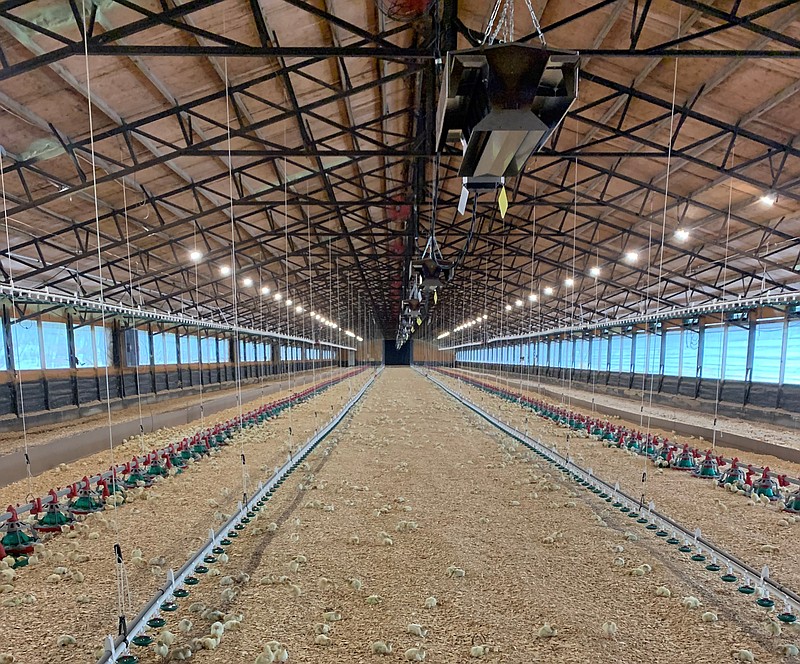A California turkey farmer and his birds are reaping the rewards of energy-efficiency upgrades made using a federal grant.
Tyler Dicus, a turkey producer, used the U.S. Department of Agriculture (USDA) Rural Energy for America Program (REAP) grant in 2021 to make energy-efficiency upgrades in his turkey barns.
It covered 25 percent of the cost for eligible items in the upgrade, which included the installation of spray-foam insulation, LED lighting, and more efficient heating and ventilation systems, among others.
According to the USDA website, the REAP grant empowers rural small businesses and agricultural producers to make energy-efficiency upgrades or install renewable energy systems, such as solar panels, for their businesses. The program offers grants for up to 40 percent of total eligible costs, or loan guarantees for up to 75 percent of total eligible costs.
Dicus and Eugene Wickham, a flock supervisor for Cargill who advises Dicus, have found the upgrades improve the quality of their birds while saving energy.
"By improving your house, your conditions, you're going to save electricity, you're going to save gas, you'll also save time, which all that equals to money," Wickham said. "... Getting your building spray-foamed, they say that will save by itself ... up to 15 to 20 percent on your propane, plus (improves) the quality of the birds."
The upgrades have allowed them to do more with less inside the barns.
Dicus said new 9-watt LED bulbs produce more light and last longer than the 100-watt incandescent bulbs they replaced. Proper lighting in the barns is crucial, as the turkeys avoid dimly-lit areas.
"The barn at night is, there's not a shadow in the barn," he said. "So there's the quality of your birds as far as (reducing) your dark spots, shadows."
In addition to using less energy, Wickham said the new bulbs also don't produce as much heat.
The same is true for the heating systems in the barns. Before, Dicus' barns had 48 pancake heaters rated at 12,000-15,000 British thermal units (Btu, a unit of heat) per hour and two box heaters rated at 250,000 Btu per hour each. Dicus replaced the pancake and box heaters with 14 quad heaters, each rated at 80,000 Btu per hour each.
"It's probably more of an even coverage of heat," Dicus said.
Wickham said the new stoves also feature two heat settings -- on or off -- as opposed to being constantly on with three heat settings. The previous stoves were always on, with three heat settings -- high burn, intermediate burn, or low burn.
New curtains and flaps on the barn's exterior help seal-in the heat. Wickham explained older barns had wood vent boards that had to be manually opened or closed. The new vent boards are automatically set to open to predetermined positions based on how old the poults are.
"We can tell it to open to, when (the poults) are young, say, only open 15 percent. As they get older, you can increase that percentage to 50 to 100 percent," he said. " And by running your vent boards like that, your curtains don't go up and down as much, where that keeps your stoves from having to run as much because once the curtain comes down, it cools off, stoves come on."
All parts of Dicus' barn are linked together to a computer for enhanced efficiency and operation.
"We can put the numbers we want in there to run, the computer to run, so that the fans will exhaust and run enough ventilation to keep air fresh, keep the air clean, keep the dust out of the barns, but yet not enough that it makes the stoves burn more than they really need to," Wickham said.
Before starting the grant process, Dicus and Wickham suggested preparing for the array of paperwork required to apply for the program.
"Before you get started, make sure you gather up ... your old information, plus what your new equipment's going to save you, so that they can compare that," Wickham said. "And it would probably even help to get somebody that's familiar with the process to come in and help you write that grant."
"There is a lot to it," Dicus added. "You have to get old bills, existing bills, all the paperwork for the items, the wattage, the Btu, and they calculate it all and put it in a grant and send it in to the USDA. Then (the USDA) make their choices of whether you get picked or not."
Dicus said he used a grant writer from Mississippi to help with the process. He said it took six to eight months before he received approval, with construction taking another four to six months.
However, the long process paid off.
"It's never a bad thing to upgrade," Dicus said.

